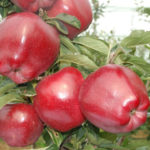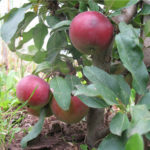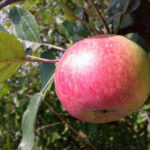Apple variety Kitayka Kerr
In Russian gardens, unusual apple trees are rarely found, which are summarized by the name "Chinese". Nevertheless, they have a lot of advantages, and not only in decorative terms. Their main quality is excellent frost resistance. The great Michurin himself was fond of experiments with these unusual species, eventually creating several well-known varieties. But not only domestic breeding paid attention to these apple trees with miniature fruits. For example, in Canada, Kitayka Kerr (or simply Kerr) was brought out, which is considered one of the best among Chinese women in terms of winter hardiness. It happened in 1952. Its creator, the famous Canadian breeder William Leslie Kerr, took as a basis the variety Long and Harrison apple (according to other sources of Haralson Red). In Russia, Kitayka Kerr appeared about 35 years ago, but few know about her. The variety is not included in the State Register of Breeding Achievements of Russia.
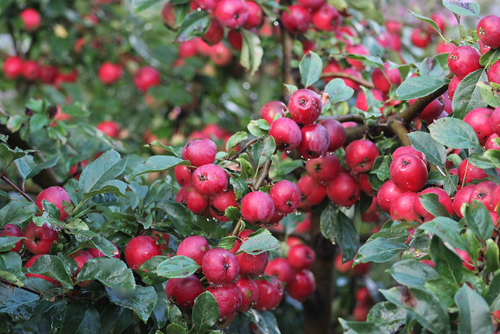
Description
The tree is small, neat, the crown is rounded, slightly spreading, not thickened. On a semi-dwarf rootstock, the height reaches 4 meters, on a dwarf rootstock - 2.0 - 2.5 meters. Shoots are greenish-brown in color, with a smooth surface, lentils are small, light. The leaves are small, elliptical in shape with a pointed tip, smooth surface, green in color. Serrated edges. Outwardly, the leaf blade resembles a plum. The petiole is short, stained with anthocyanins. In the process of flowering, pink buds first appear, which gradually turn into white, rather large five-petal flowers. Inflorescences of the umbrella type variety, each may contain more than 4 flowers. In spring, the apple tree attracts the eye with abundant flowering. During the period of full ripening of the fruits, the tree looks no less impressive, the branches are simply thickly hung with red apples.
The fruits of Kitayka Kerr are bright, elegant, slightly elongated. During the ripening period, they are painted in a dark red, almost burgundy color. A bluish waxy coating is visible on the skin. The funnel is shallow and narrow. The peduncle is relatively long, of moderate thickness, colored. The saucer is wide, the calyx is closed, the sepals are slightly protruding. The pulp is quite dense, juicy, colored in a red-pink tint. 100 grams of raw material contains from 10 to 20 mg of ascorbic acid, about 40 mg of P-active catechins. Antioxidant activity for dihydroquercetin is not less than 200 mg. The taste is interesting, full-bodied, sweet and sour, with a slight characteristic astringency. Of all the varieties of Chinese women, it is our heroine that is considered the largest-fruited - her fruits are about 7 cm in diameter, weighing from 20 - 30 to 40 grams.

Variety characteristics
- In the period of fruiting, Kitayka Kerr enters quite early. Already 3-4 years after planting a one-year apple tree seedling, you can get acquainted with the unusual taste of the fruit;
- in terms of ripening, our heroine belongs to the autumn varieties. Most of the harvest ripens in September. But in the south of the Moscow region, you can shoot apples already at the end of August, if you are lucky with the weather. In cooler regions, mid-September;
- there are no exact data on productivity, but, according to reviews, fruiting is always pleasing;
- winter hardiness of the culture is excellent. The tree easily tolerates frosts, approaching -30 ° C and slightly higher. The apple tree feels great in the Moscow region, it grows even in the West Siberian and Ural regions;
- in addition, the plant compares favorably with drought resistance;
- our heroine is an excellent pollinator for other species;
- the immunity of the variety is quite high, there is resistance to the main diseases of apple trees. The fruits of Kitayka Kerr are practically not affected by scab;
- ripe apples hold tightly on the branches, so you can take your time with the harvest, which is very convenient for summer residents who visit their plots only on weekends;
- fruit transportability is good. Keeping quality is excellent, if the storage conditions are observed, the crop can lie until January, without losing either its visual appeal or taste;
- the way of use is universal.Apples can be used naturally. True, the variety is most popular for the preparation of an exotic product - paradise apple jam. The crop is also processed into jams, compote is boiled, frozen, dried.
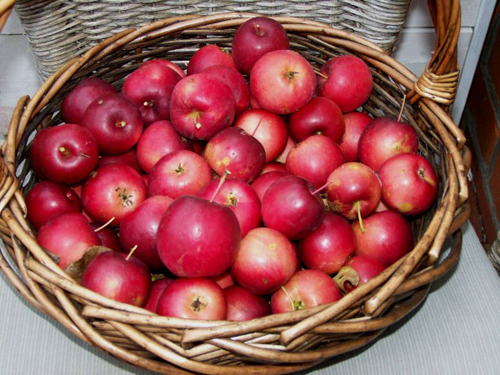
Planting and leaving
For planting a two-year-old seedling Kitayka Kerr, the autumn time is suitable, or rather, the end of September or the beginning of October. The main thing is that at least 2 - 3 weeks remain before the onset of stable cold weather. During this time, the seedling will have time to take root and calmly enter the dormant period. Choose a place for landing that is sunny, protected from the prevailing winds in winter. Prepare the planting hole about a month before the procedure, so that the fertilizers applied have time to dissolve in the soil and do not harm the roots. The subsoil water level is no closer than 1.5 meters to the soil surface. The care of the variety is pretty simple. The compact crown requires virtually no intervention. Sanitary pruning is done as needed. It's a different matter when an apple tree grows in the Siberian region. There they try to give the plant a stale shape. So it is more convenient to protect the tree from wind and frost in winter. The rest of the agricultural technology is generally in line with the generally accepted. Young trees are watered more often, the first flowering is almost completely prevented, in order to enable the plant to take root in a new place as soon as possible.
Chinese Kerr is an amazing culture. Outwardly, a spectacular tree can decorate any corner of the garden. Small, but with an unforgettable taste, fruits in winter will remind you of summer not only in their natural form, but also in wonderful jam made from whole apples. In central Russia, caring for a crop is quite simple, this process facilitates good immunity and sufficient winter hardiness of the plant. But in the northern regions, these indicators are tested by unfavorable weather conditions. Therefore, leaving is somewhat complicated. But a properly formed crown, launched parallel to the ground, will allow the plant to receive more sunlight, and in winter it will make it possible to shelter the apple tree under a snowdrift from frost and wind. The big drawback is that it is quite difficult to find in horticultural centers. To acquire seedlings, those who want to acquire this wonderful plant often have to look for those gardeners through friends who have this curiosity growing for more than a dozen years.
